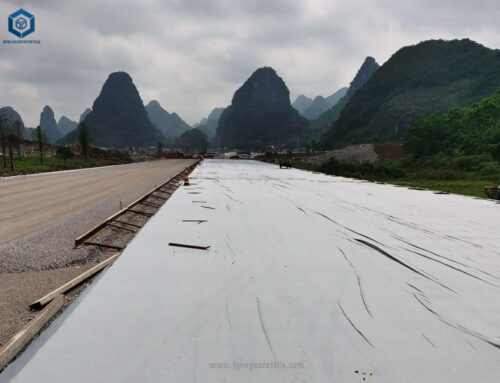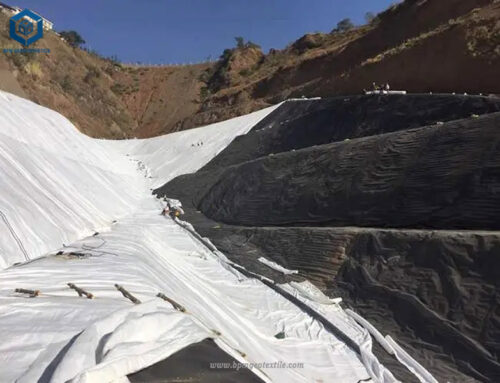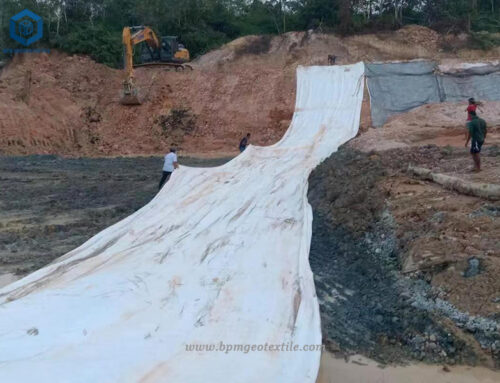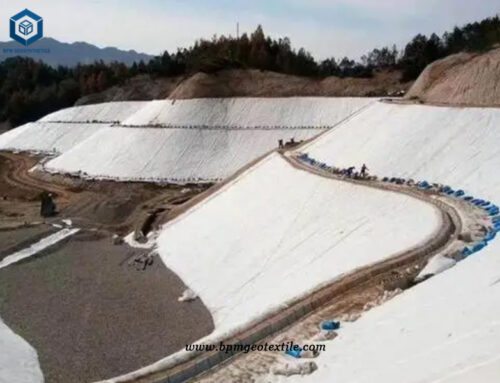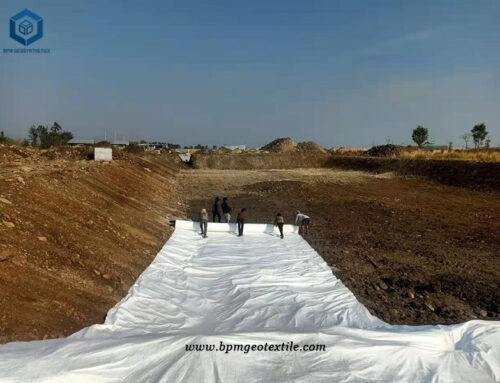Nonwoven geotextile underlayment fabric, also knwon as nonwoven geotextile fabric, provides separation between different layers of soil or materials, preventing them from mixing and compromising the overall structure. They also offer drainage capabilities, allowing excess water to be efficiently drained away, reducing the risk of water accumulation and potential damage. Nonwoven geotextile underlayment fabrics can prevent the passage of unwanted particles while allowing water to flow through with their filtration properties. This helps to maintain the integrity of the underlying soil and prevent erosion.
As the leading manufacturer and supplier in the industry, BPM Geosynthetics offers a diverse selection of high-quality nonwoven geotextile underlayment fabrics. These fabrics can be tailored to meet the specific requirements of different projects, ensuring optimal performance and durability.
1. What Is Non Woven Geotextile Underlayment Fabric?
Non woven geotextile underlayment fabric can be made of either polyester or polypropylene but the majority of non woven geotextile fabrics are made of polypropylene staple fiber and are needle punched. Nonwoven geotextile underlayment fabric is a permeable textile material extensively used in civil engineering projects, structures, and systems. BPM nonwoven geotextile underlayment fabric is made from pre-stressed polypropylene yarns intertwined longitudinally with polyester and transversely with each other using a woven method. These yarns are then entangled to form a stable fabric pattern through a special warp straight matting process. The fabric exhibits high tensile strength and excellent resistance to UV radiation and chemical substances.
Nonwoven geotextile underlayment fabric serves as a versatile alternative to natural materials in infrastructure construction and repair projects. It offers controlled fabrication with predetermined properties, rapid installation, and compactness, making it a preferred choice for various applications.
Typically composed of polypropylene, nonwoven geotextile underlayment fabric is specifically designed for use in projects such as retaining walls, drainage systems, and soil separation. It allows for high water flow rates while maintaining dimensional stability. The fabric is resistant to rot and mildew, making it suitable for permanent installations. BPM offers a range of options in terms of weight and roll sizes, ensuring compatibility with diverse project requirements.
BPM Geosynthetics offers a wide range of nonwoven geotextile underlayment fabrics that provide essential functions such as filtration, separation, and drainage. These fabrics effectively protect against soil erosion and ensure the stability of various construction projects.
2. What Is Non woven geotextile underlayment fabric Used for?
Nonwoven geotextile underlayment fabric is widely used for various purposes in civil engineering and landscaping projects. Its unique properties make it suitable for a range of applications including:
2.1 Drainage protection
Nonwoven geotextile underlayment fabric is often used to protect drainage systems by preventing soil particles from clogging pipes or drains. It allows water to pass through while filtering out unwanted debris.
2.2 Erosion control
The fabric helps to prevent soil erosion by stabilizing slopes, embankments, or shorelines. It provides a protective layer that retains soil particles while allowing water to drain, reducing the risk of erosion.
2.3 Filtration
Nonwoven geotextile underlayment fabric acts as a filter, allowing water to pass through while retaining soil particles and other contaminants. It is commonly used in applications such as stormwater management, retaining walls, and subsurface drainage systems.
2.4 General landscape applications
The fabric is used in landscaping projects to separate different soil layers, prevent weed growth, and promote healthy plant growth. It provides a stable base for pathways, driveways, and garden beds.
Nonwoven geotextile underlayment fabric serves essential functions such as drainage protection, erosion control, filtration, general landscaping, and stabilization/separation. Its versatility and performance make it a valuable component in a wide range of civil engineering and landscaping projects.
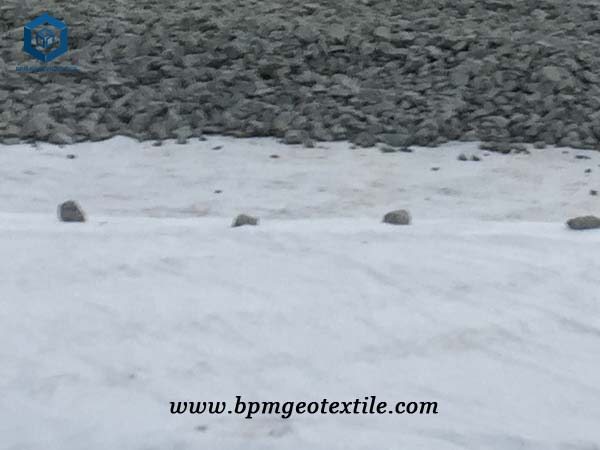
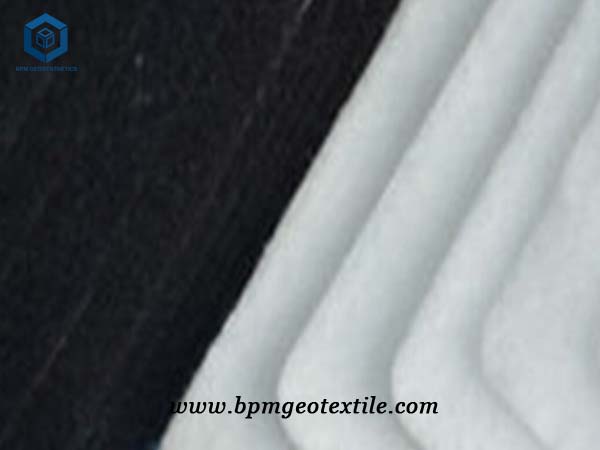
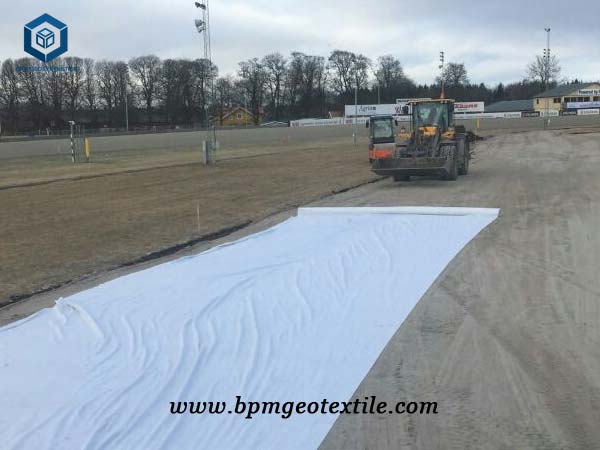
3. How Long Does Non Woven Geotextile Last?
The lifespan of nonwoven geotextile can vary depending on various factors such as the quality of the fabric, the specific application, environmental conditions, and maintenance. In ideal conditions, where the fabric is undisturbed, protected from UV exposure, and installed correctly, it can last up to 50 years.
However, it’s important to note that nonwoven geotextile is designed to be a durable and long-lasting material. It is resistant to degradation from chemicals, biological factors, and environmental stresses. Proper installation techniques, including adequate anchoring and protection from sharp objects, can also contribute to the longevity of the fabric.
Realistically, the lifespan of nonwoven geotextile can range from 20 to 40 years in most applications. Regular inspections and maintenance can help identify any signs of wear or damage and take appropriate measures to extend its life.
It’s always recommended to consult with the manufacturer or a geotechnical engineer for specific guidance on the expected lifespan of nonwoven geotextile in your particular application.
4. Does Non Woven Geotextile Fabric Put Under Gravel?
Nonwoven geotextile fabric is commonly used as a stabilizing layer beneath gravel. Its high tensile strength helps to stabilize the initial layer of gravel, preventing it from sinking or shifting over time. By reinforcing the structure of the gravel layers, the fabric ensures long-term stability. Without the use of geotextile fabric, the first layer of rocks may gradually sink into the ground, compromising the integrity of the gravel surface. Therefore, incorporating nonwoven geotextile fabric beneath gravel provides a reliable solution to maintain the stability and durability of the gravel structure, preventing settling and promoting a more robust and long-lasting construction.
5. Case Study of Non Woven Geotextile Underlayment Fabric Philippines for Expressway Construction
Nonwoven geotextile fabric has indeed become a versatile and cost-effective material for ground modification in various engineering fields. Recently, we received an inquiry from a customer in the Philippines regarding their expressway construction project in Cebu. The customer specifically requested a range of nonwoven geotextile underlayment fabric specifications, including 125GSM, 150GSM, 200GSM, 320GSM, and 420GSM.
In response, we promptly provided our customer with samples of the requested nonwoven geotextile fabric, along with detailed information about its functions and the proper laying process. Our commitment to delivering high-quality products was acknowledged, and our customer quickly recognized the value of our offerings.
As a result, a strong cooperative relationship was established, leading to the swift signing of an order. We are delighted to support our customer’s expressway construction project in Cebu with our reliable nonwoven geotextile underlayment fabric solutions.
6. Specifications of Non Woven Geotextile Underlayment Fabric Philippines
- Roll size-4m×100m;4m×50m;4m×250m;
- Total quantity-200,000 m2
7. About BPM Geosynthetics
BPM had provided many types of effective and states of the art geomembranes, geotextile and other geosynthetics to over 81 countries.
BPM is also providing professional design and installation service. OEM and ODM are also available. If you have any questions or inquiries, please contact us, we will reply as soon as possible.

